Ask the #SMXperts series — B2B SEM: Meeting challenges with smart tactics
Three very smart SMXperts share their knowledge on cross-channel tracking, LinkedIn strategies and more in this extended Q&A session from SMX West.
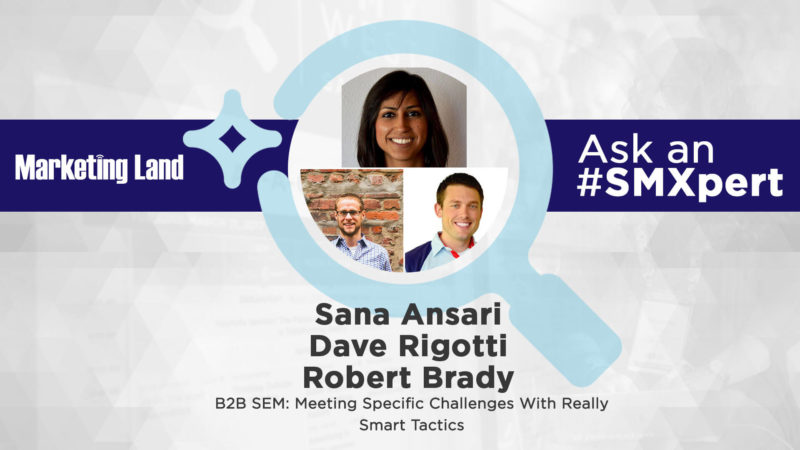
The Ask the SMXpert series continues the question and answer (Q&A) segment held during sessions at Search Marketing Expo (SMX) West 2018.
Today’s Q&A is from the B2B SEM: Meeting Specific Challenges With Really Smart Tactics session with Sana Ansari, Robert Brady and Dave Rigotti. It features an introduction from moderator Brad Geddes.
Brad Geddes
The B2B SEM session at SMX West was filled with actionable tips, tactics and pitfalls to avoid. The session started with Sana Ansari explaining how to fill the business-to-business (B2B) funnel with a cross-channel lead-nurturing system.
Next, we had Robert Brady walking the audience through the biggest B2B mistakes and how to avoid them.
Finally, Dave Rigotti showed us how his company opens up its content to everyone and focuses on the overall business and not lead generation.
Given all the content and ideas that were shared, a lot of questions flowed from the audience. In fact, we couldn’t come close to getting through them all. In this article, we will explore some of the unanswered questions and get some expert answers.

Dave Rigotti
Slide deck: Growing SEM’s Impact with Omni-Format Content
Question: I have a question about content marketing for David. I find fewer and fewer people are willing to click to read a full blog on the website. Would you recommend shortening the posts so you can post the entire article on social? Is it more important for people to read your content, or is it more important to capture their cookie?
Dave: Advertising is a value exchange. You need to give something in order to get anything in return, whether it’s a click, cookie, read, etc. Understanding which piece to optimize for can be a real challenge!
For B2B companies specifically, I recommend thinking about driving to the next stage by tracking the funnel using multitouch attribution.
For example, if your ad points to a blog post, but they never move further down the funnel, you will naturally start to optimize that blog post for that purpose. Thinking about content through the entire funnel is really important, too, since the actions to drive the next stage vary.
Another example: At the top of the funnel, you likely want the prospect to give you their contact information. Reading the content matters a little less.
At the bottom of the funnel, you probably already know who they are (assuming sales is speaking with them), and you want to point out why you are better than a competitor. In this case, reading the content really matters.
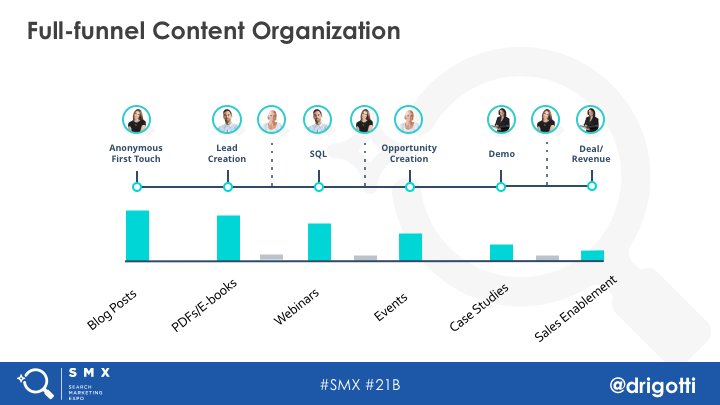
Question: Let’s talk six-month-plus sales cycles. You don’t want to jam forms down their throat from the beginning, but simply spending money on awareness (via ungated content) doesn’t always look good in the eyes of execs. Thoughts or ideas on this?
Dave: Don’t call it awareness! Call it sales enablement.
Instead of pitching the “brand exposure” (marketing-centric view), pitch how it will help the sales team and business drive more revenue. Make the case for how you are “warming” and “educating” the accounts prior to sales outreach to increase outbound sales conversion, win rates, sales velocity and revenue, too.
Question: I like the idea of buying the first click on LinkedIn to bring people into the funnel. If I want to only buy the first click on LinkedIn, is there a way to exclude people who have clicked on my LinkedIn ad from seeing my ad moving forward?
Dave: I’d first encourage you to think about the entire funnel, not just the top.
If some LinkedIn ads could help open sales opportunities convert to won at a higher rate, wouldn’t your business want you to run that campaign? If you must keep LinkedIn to the top of the funnel, consider using their target account (list upload) functionality. You can then build your lists via your CRM and remove the accounts after they have had an initial conversion.
Robert Brady
Slide deck: The 4 Biggest Mistakes in B2B PPC And How You Can Avoid Them
Question: How do you find parallel audiences?
Robert: As I shared in my presentation, we found that for grass-fed beef customers, a large number of them were homeschooling their children (or had). This allowed us to reach potential new customers. Discovering the parallel audiences in your own business requires three main factors:
- Talk to your customers. You need to talk to them or talk to the people who are regularly in contact with them. Interview your top sales rep or customer support rep. THE best, not just who’s available.
- Find common threads. If you only focus on age, gender, industry, seniority, job title, income, etc., then you won’t likely surface these insights. Look at their social media profiles and see what groups they are members of (outside your industry/space), what they post about (that isn’t about your industry/space), etc.
- Use intuition. During WWII they studied where bullet holes were in planes that returned from bombing runs. The goal was to add additional armor for safety. The data showed the most bullet holes in the fuselage. However, adding more armor to the fuselage would have been a mistake. Armor needed to be added to the wings and engines because planes hit there didn’t return and therefore weren’t in the data. You need intuition to spot parallel audiences because they might be hiding in your blind spots.
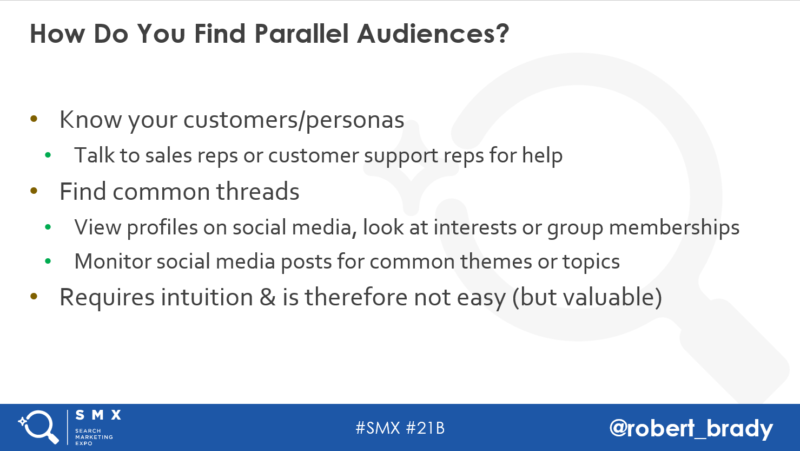
Question: Do you or your clients have concerns about marketing B2B products on Facebook or Instagram since the audience may be in a more ̢personal mindset on Facebook as opposed to Twitter or LinkedIn?
Robert: This slide perfectly sums up my answer to this question:
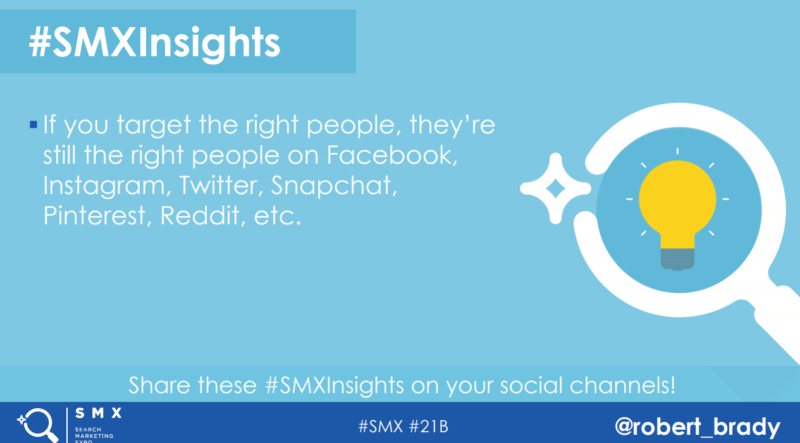
Question: I like the idea of buying the first click on LinkedIn to bring people into the funnel. if I want to only buy the first click on LinkedIn, is there a way to exclude people who have clicked on my LinkedIn ad from seeing my ad moving forward?
Robert: To exclude someone from your LinkedIn campaigns after they’ve already clicked an ad, you need to create an audience of those people. Assuming you use custom landing pages, this is easy.
Name the audience something like “LinkedIn Ad Clickers” and define them as anyone who hit a certain uniform resource locator (URL) or visited a page with your URL parameter (i.e. utm_source=linkedin&utm_medium=cpc).
Then exclude this audience from your LinkedIn campaigns so they won’t see an ad after clicking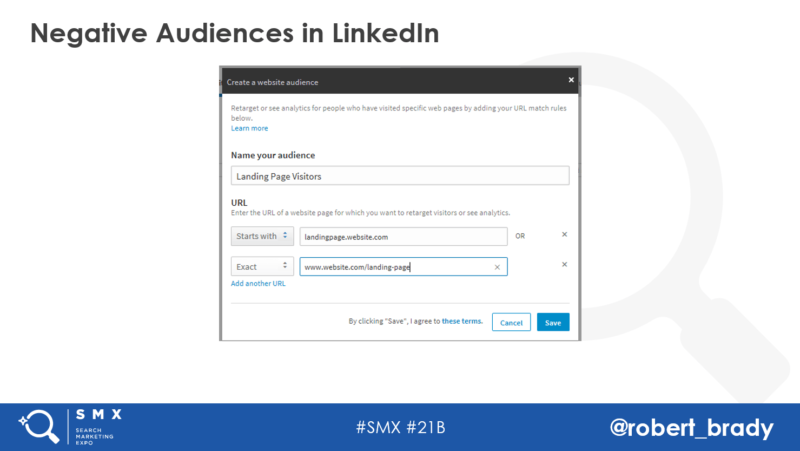
Sana Ansari
Slide deck: Effectively Driving B2B Sales – Cross Channel Paid Media and Nuture Strategy
Question: What is your approach to cross-channel tracking or cookie dropping? If the user from your initial LinkedIn campaign doesn’t fill in a form on the landing page, then how do you track them down on other socials?
Sana: First and foremost, we’ll always want to leverage Google Analytics as a point of truth. This is where you can see different click paths, how certain channels play a role in the funnel and understand the value of each channel. You will be able to see if someone has come through on Linkedin without a conversion but later on come through Facebook and converted.
Additionally, another thing we often do when testing out new channels is that in our remarketing efforts, we will typically create a separate remarketing adgroup/ad set targeting only audiences that have come from that channel.
So, in this example, if we are testing out Linkedin, we would tag it with Urchin Tracking Module (UTM) parameters and have Facebook remarket specifically to that. (UTM = the tracking parameters that allow you to pass data to Google Analytics).
This way, although at the first touch they may not have converted, we can truly understand if our LinkedIn efforts are filling the funnel and equating to conversions via remarketing efforts on other channels.
Question: Given the long sales cycle and not so much search volume, how do you run A/B split testing in B2B SEM?
Sana: Typically, you want to find earlier touch points within the funnel which indicate high intent and base your results off of that information, rather than waiting six months down the line.
So, for example, rather than using the most shallow “lead” or “demo” conversion point, take it one step further and leverage more qualified conversion touch points such as marketing qualified leads (MQLs), which you can get data for without waiting as long to identify winners of tests.
Question: Let’s talk six-month-plus sales cycles. You don’t want to jam forms down their throat from the beginning, but simply spending money on awareness (via ungated content) doesn’t always look good in the eyes of execs. Thoughts or ideas on this?
Sana: Typically, after developing the right awareness strategy, the best way to get buy-in is to propose a sandbox test and budget, along with how you will quantify the efforts of your awareness program. This way you can assess the monetary value that your awareness efforts are bringing in (given that is always the end goal).
By limiting budgets to show performance results before scaling further, this makes it easier for execs to give you their initial buy-in.
Question: Do you or your clients have concerns about marketing B2B products on Facebook or Instagram, since the audience may be in a more personal mindset on Facebook as opposed to Twitter or LinkedIn?
Sana: This tends to be a natural concern many companies have! However, channels such as Facebook deliver immense reach and their targeting capabilities can get you in front of the right audiences.
At the end of the day, our typical goal with these channels is to generate demand, fill the funnel and measure its impact on bringing in business. Facebook provides more volume and significantly cheaper costs-per-click (CPCs), so although you may (or may not!) see lower conversion rates (CVRs), the CPCs often more than account for the lower CVRs. It is definitely worth testing.
Have a question we didn’t cover?
Do you have more questions for our SMXperts? Complete this form and we’ll run your question and the SMXpert responses shortly!
Want to learn more in-depth technical SEO tactics? Join us next month at our SMX Advanced conference in Seattle, where top industry experts will share their tips, tactics and strategy around these topics and more:
MarTech is owned by Semrush. We remain committed to providing high-quality coverage of marketing topics. Unless otherwise noted, this page’s content was written by either an employee or a paid contractor of Semrush Inc.
Related stories
New on MarTech